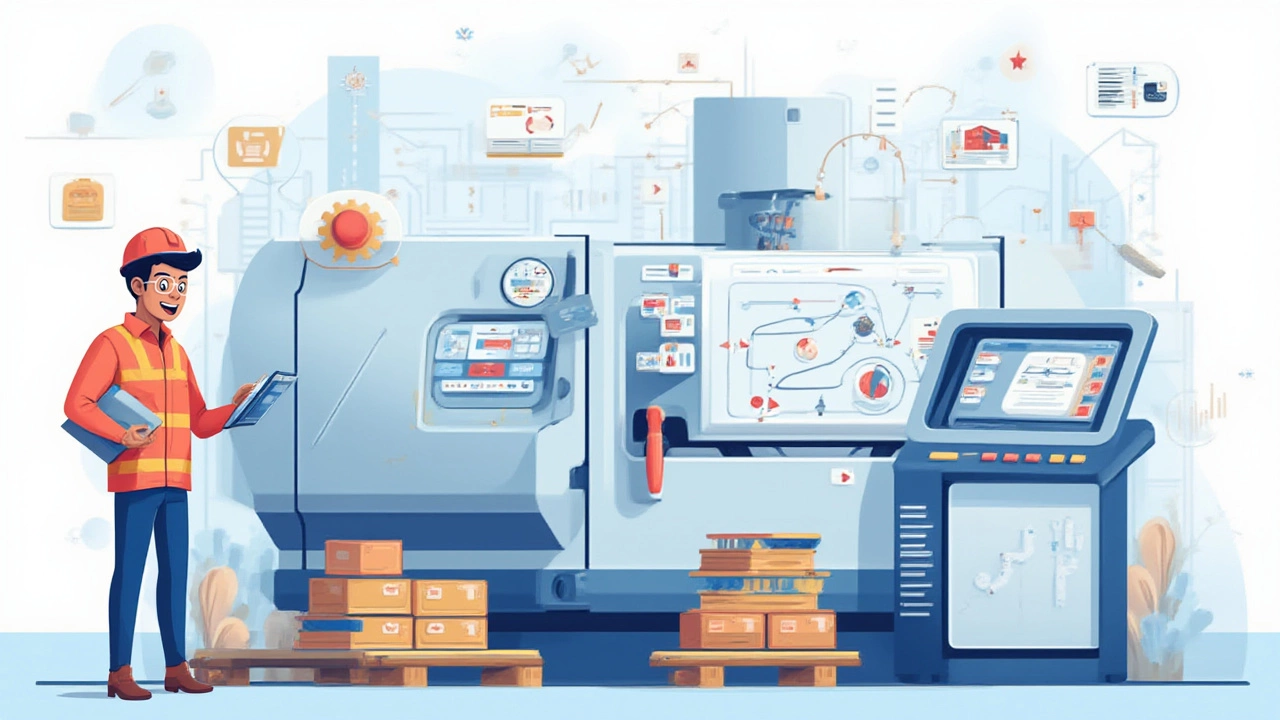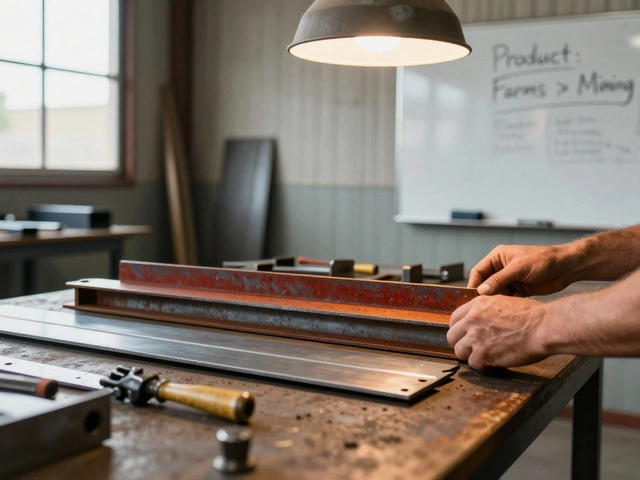Understanding the 5 M's of Manufacturing: Key Elements for Success

Imagine a production line running like clockwork, but suddenly the output drops, and nobody knows why. It’s a nightmare for any manufacturer, big or small. Here’s the not-so-secret truth: almost every issue on a shop floor can be traced back to one or more of the famous 5 M’s—Man, Machine, Material, Method, and Measurement. This framework isn’t some dusty old theory from forgotten textbooks; it’s an everyday tool for troubleshooting, efficiency, and boosting profits in factories from Sydney to Shanghai.
Meet the 5 Pillars: Man, Machine, Material, Method, Measurement
The 5 M's of manufacturing might sound basic, but they pack a serious punch when it comes to building, running, and fixing production processes. Let’s break them down so you can see how each one shapes a plant’s day-to-day success—and where things can go off the rails if you ignore them.
Man isn’t just about having people on the floor. It’s about their skills, motivation, experience, and even mood. You can throw the world’s best robots into a factory, but if your team isn’t trained, cared for, or safe, production stalls or quality plummets. Studies by the Australian Industry Group show that companies investing in training see up to 24% fewer machine breakdowns. That’s why some of the best manufacturers focus fanatically on workforce upskilling and safety culture. Ever wonder why Toyota’s assembly lines pause production for even small safety talks? That’s Man in action.
Now, Machine doesn’t just mean equipment—it’s every piece of gear used to get the job done, from gigantic mills to humble hand tools. Old, poorly maintained machines are the biggest culprits in downtime and accidents. In 2022, Australian manufacturing lost more than 38 million work hours due to unplanned equipment failures. Smart companies use predictive maintenance systems, sensors, and even AI-powered diagnostics to keep machines humming. If a Sydney-based electronics plant runs three shifts round the clock, even a single hour’s breakdown translates into big cash lost.
What about Material? Every product starts as some kind of raw input—steel, plastics, textiles, chemicals—and the choice, quality, and reliability of materials set the foundation for everything else. Imagine paying for premium copper for cables, only to get a batch that was contaminated during shipping. It’s a ripple effect: product defects, warranty claims, angry customers. To avoid this, some Aussie firms lock in long-term contracts with trusted suppliers and do regular incoming quality checks. Just look at the food industry, which works with tight tolerances and strict safety rules; even a single rotten batch of produce can shut down a whole production line.
Method means the step-by-step instructions, recipes, or ‘how-to’ guides that workers and machines follow. A great method reduces mistakes, overwork, and confusion. It can be as detailed as a 30-step assembly SOP (Standard Operating Procedure) or as simple as a checklist. Over time, top manufacturing firms tweak and update their methods to squeeze out wasted effort or adapt to market changes. After all, even a small improvement in the method can lead to millions in extra profits. Just ask the automotive industry—car makers like Hyundai have shaved minutes off build times by reworking job sequences and investing in lean manufacturing approaches.
The last M is Measurement. If you don’t know what’s going on, how do you fix or improve it? This is where data comes in. The best manufacturers measure everything—cycle times, yield rates, defect percentages, energy use. This isn’t “big brother” management, either. It’s about giving teams the numbers they need to spot trends, zero in on problems, and celebrate wins. For instance, a 2023 report from CSIRO found that Aussie manufacturers using real-time data reduced waste by an average of 15% in a single year. These companies rely on dashboards and automated tracking, not just clipboards and guesswork.
Here’s a table showing the impact of each M in some real-life Australian manufacturing scenarios:
| M | Example Issue | Impact if Ignored | Typical Improvement |
|---|---|---|---|
| Man | Staff without up-to-date training | Increased errors, lower morale | Quarterly skills updates |
| Machine | Skipping maintenance | Unplanned downtime | Predictive maintenance systems |
| Material | Inconsistent supplier deliveries | Production stoppages | Approved supplier lists |
| Method | Outdated assembly steps | Slow, inconsistent output | SOP reviews, lean audits |
| Measurement | No data collected | Trouble diagnosing issues | Digital dashboards |
If you’re running or planning a business, keep these 5 M’s up your sleeve. They’re the starting point for almost every improvement project or problem-solving blitz in manufacturing.

How the 5 M’s Drive Performance and Problem-Solving
The magic of the 5 M’s is that they’re not just labels—they’re a practical checklist for boosting quality, cutting costs, and keeping customers happy. Too many factories chase big ideas like automation or AI, when the real answers are often in fixing a simple gap in one M.
Let’s say your factory is seeing a rise in defective products. Start with Man: are workers being rotated too often, or have new hires skipped training? Jump to Machine: are calibration logs up-to-date, or are breakdowns rising? Swing over to Material: is the latest batch from the supplier matching your specs? Method time: has someone deviated from the usual SOP, maybe because of a rush order or a missing tool? Finally, Measurement: do you have clear data pinpointing when and where defects started showing up—was it one machine, shift, or material batch?
It gets interesting when you dig into how companies actually use the 5 M’s. After a Sydney auto component maker faced a spike in warranty returns, managers mapped every step of the 5 M’s. They spotted a pattern: one obviously tired shift supervisor was filling two roles due to staff shortages (Man), while the intake inspection (Method) was skipped to catch up. Problem solved once they fixed their staffing and re-established strict quality checks.
If you ever do a root cause analysis, you’ll see the 5 M’s pop up constantly—as the backbone of fishbone (Ishikawa) diagrams. These diagrams literally branch out the M’s from a problem, letting teams brainstorm potential causes in each area, instead of just guessing or blaming luck. The 5 M’s help replace finger-pointing with fact-finding.
Don’t overlook Measurement—in today’s factories, this means leveraging Industry 4.0 tools. Real-time sensors, connected machines, and smart analytics make it possible to measure temperature, vibration, working hours, and much more. Big players like BHP and Bluescope Steel are pouring millions into digital dashboards that alert teams instantly to even tiny process drifts. This means you catch issues before they snowball into major problems. Some SMEs in New South Wales are even using affordable cloud-based monitoring to get the same edge as giant multinationals. Data gives every manager and floor worker a clear, unbiased view.
When all 5 M’s line up, you get what everyone wants: smooth production, high quality, lower costs, and a safer workplace. Miss even one, and it’s like driving with a flat tire—you can still move but everything feels clunky and stressful.
For everyday manufacturing problems, here’s a super simple process for using the 5 M’s framework:
- Spot the issue (e.g., drop in output or rise in defects).
- Gather data and map the 5 M’s for the problem area.
- Test fixes or improvements one M at a time—don’t try to tweak everything at once.
- Measure again to see what changes stick and what needs more work.
- Document your findings so you’re not reinventing the wheel next time.
Pro tip: Involve workers on the floor whenever you review the M’s—they’ll spot practical issues that management often misses. During a recent rollout of new machinery in a Parramatta plastics factory, it was line staff who pointed out that heat from the new equipment was affecting some materials. That’s real-world Measurement in action—a finding backed up by data and experience, not theory.

Real-World Tips for Mastering The 5 M’s of Manufacturing
You don’t need an army of consultants or expensive management books to get the 5 M’s working. The best results come from everyday habits, open eyes, and a willingness to tweak systems as you go.
First off, make the 5 M’s a living document in your workplace. Don’t just talk about them in training and forget till trouble strikes. Many Aussie firms keep big 5 M posters in break rooms or make the M’s the backbone of daily huddles. When everyone speaks the same language, it’s easier to spot a failing Machine or dodgy Material before it tanks your output.
The human factor (Man) doesn’t end with hiring the right people. Regular training, feedback, and simple appreciation can cut errors almost as much as any machine upgrade. And don’t ignore mental health—fatigued or stressed workers make more mistakes. Some local firms now rotate jobs or offer wellness programs that cut both absenteeism and accidents. Recent stats from SafeWork Australia show that manufacturing with strong safety and wellness programs report 27% fewer on-the-job accidents.
When it comes to Machine, the cheapest fix is usually prevention. Set up alerts for scheduled maintenance and random audits—even for hand tools, not just the big gear. If something sounds or smells wrong, trust the instincts of your team. One classic tip: record weird noises on a phone and play the audio for your maintenance chief—it works better than any email report. And remember, even the fanciest machines can tank your output if the right parts aren’t in stock; a $3 bolt can ruin a $30,000 batch.
Material is all about relationships. Build tight connections with suppliers who know your quality demands. Some local food producers run surprise audits on their own vendors’ warehouses—no warning, just an honest checkup on the goods and storage. This way, they’re less likely to be caught off guard by a dodgy delivery and more likely to catch problems long before products hit the shelves.
Method is the beating heart of standard work. Don’t get bogged down in documentation for documentation’s sake. Keep instructions short and visual—step-by-step diagrams and quick-reference cards beat wordy manuals every time. Give staff the power to suggest changes. More than once, a new hire has saved everyone time just by reordering a process step nobody questioned for years. Don’t be afraid of a “Why are we doing it that way?” culture—it’s your ticket to improvement.
On Measurement, don’t just collect numbers for the sake of filling spreadsheets. Pick critical KPIs—think first-pass yield, on-time delivery, scrap rates—and update them in real time where everyone can see. Celebrate when the team hits targets and drill down when numbers slip. If you don’t measure, you’re guessing. If you measure too much, you get bogged down. Find your sweet spot and stick to it.
If you’re just starting out, focus on one M a month and track improvements. Within six months, most businesses see noticeable gains—less downtime, better product quality, and happier teams. The 5 M’s don’t care what you make, or how big you are; they’re the nuts and bolts of success whether you’re building jet engines or handcrafting eco-friendly surfboards out of Byron Bay.
The real trick is honesty. Don’t fudge the numbers, hide problems, or blame “the system.” Use the 5 M’s to get clear eyes on what works and what needs fixing. That’s how Australia’s best manufacturers stay sharp, adapt fast, and keep customers coming back.





